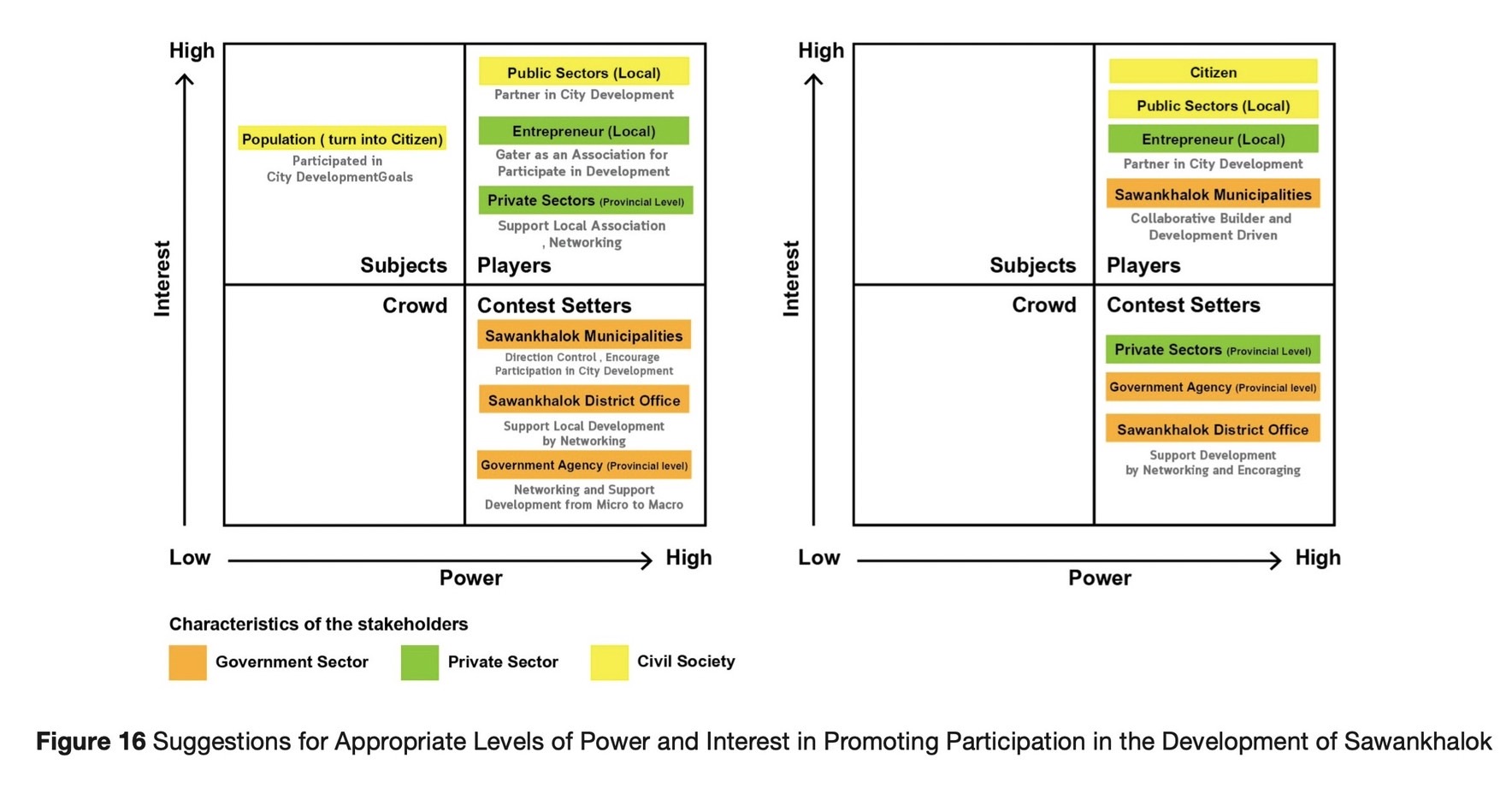Stakeholder Analysis in Urban Development in The Case of Sawankhalok City
Main Article Content
Abstract
This study is a significant part of an action research ‘In Searching for Appropriate Public Participation in the Medium Size Old City Planning Process in the Case of Sawankhalok City.’ It discusses conducting stakeholder analysis for understanding of the roles, powers, interest levels, and the relations between groups of stakeholders, in the Sawankhalok City Development Participation Project supported by the Community Organizations Development Institute in Thailand. This research classifies three key groups of the stakeholders as: governmental offices, private sector, and civil sector. One of the governmental offices, the Sawankhalok Town Municipality Comment: Is this the full title of the governmental office?], has the major role in the city’s development. It has the highest power to control the city’s development direction, as well as the greatest interests and influence in the city’s development. This research also found out that in the civil sector, both non-profit organisations and the people of Sawankhalok, have low levels of participation in the city development process. The study suggests that to create sustainable city development, an appropriate level of participation should be made available by enhancing the power and interest level of those in the non-governmental sector. Two suggestions are presented for short-term and long-term procedures. The short-term procedure is to encourage an atmosphere of city development participation by transforming the local government’s role responsibility from being the main player to being a supporter. Such a change can provide more opportunities and encourage increased levels of interest in participation from the civil sector. After the transformation gradually changes and becomes a concrete value of the city development process, then the long–term strategy will be developed to empower the stakeholder’s roles, their power, and their interests to the level of equality and equity. That implementation among all sectors can accordingly facilitate a level of city development co–creation that can raise the city development direction to that of a liveable and sustainable city.
Downloads
Article Details

This work is licensed under a Creative Commons Attribution-NonCommercial-NoDerivatives 4.0 International License.
All material is licensed under the terms of the Creative Commons Attribution 4.0 International (CC-BY-NC-ND 4.0) License, unless otherwise stated. As such, authors are free to share, copy, and redistribute the material in any medium or format. The authors must give appropriate credit, provide a link to the license, and indicate if changes were made. The authors may do so in any reasonable manner, but not in any way that suggests the licensor endorses you or your use. The authors may not use the material for commercial purposes. If the authors remix, transform, or build upon the material, they may not distribute the modified material, unless permission is obtained from JARS. Final, accepted versions of the paper may be posted on third party repositories, provided appropriate acknowledgement to the original source is clearly noted.
References
Arnstein, S. R. (1969). A Ladder of citizen participation. Journal of the American Planning Association, 35(4),216–224.
Boonkam, D. (2015). Policy proposal: Urban planning constitution. In Y. Kadkankly (Ed.), Thailand’s futureurban development: Obstacles, policy mechanisms and solutions. Metropolitan and Urban Studies Center Rangsit University; The Foundation of Public Intellectual Creative Institute (CPWI) Under the City’s Future Development Public Policy Plan.
Bryson, C. (2004). What to do when stakeholders matter: A guide to stakeholder identification and analysistechniques. Public Management Review, 6(1), 21–53.
Buaniew, J. (2007). Participation in local research. The Thailand Research Fund (TRF) Regional Office.
Chimmachui, A. (2020). Thai Way. http://www.skcc.ac.th/project/learning/ge0402/02.pdf
Choocherd, K. (2005). Reflective: Methodology to enhance learning for civil society practitioners. Thai Health Promotion Foundation.
Cohen, J. M., & Uphoff, N. T. (1977). Development participation: Concepts and measures for project design,implementation and evaluation. World Developments.
Cohen, J. M., & Uphoff, N.T. (1980). Participation’s place in rural develop: Seeking clarity through specificity.World Developments.
Department of Town and Country Planning Ministry of Interior. (1998). Data analysis report for urban planningof Sawankhalok. Department of Town and Country Planning.
Eden, C., & Ackermann, F. (1998). Making strategy: The journey of strategic management. Sage.
Kanchanaphan, A. (2015). A series of books: Assessing and synthesizing cognitive status from cultural research.Department of Sociology and Anthropology, Faculty of Social Sciences, Chiang Mai University.
MacIsaac, D. (1995). An introduction to action research. https://physicsed.buffalostate.edu/danowner/actionrsch.html
Ratanavaraha, A. (2020). Shrunk cities. https://www.the101.world/shrunk-cities/
Songkhla Heritage Trust. (2016). Activities of Songkhla Heritage Trust. https://www.songkhla-ht.org/activities.
Sukhothal Provincial Office. (2017). Sukhothai provincial development plan (2015 – 2018) fiscal year 2017review edition. http://www.sukhothai.go.th/sukhothai/index.php/th/component/content/article/2-uncategorised/854-strategic-plane02
Sutiyyamanee, V. (2015). From rural to urban: Factor influencing and impact of migration, Kasem BunditJournal, 16(1), 102-112. https://so04.tci-thaijo.org/index.php/jkbu/article/view/34695
Tangsiriphat, R., & Tangcharounsatien, V. (2013). Stakeholder analysis. Journal of Health Science, 12(6),865–875.
TerraBKK Knowledge Center. (2017). Which cities should I move to? Based on the 2057 Thailand developmentplan. https://www.terrabkk.com/news/191053
Thai Environment Institute. (2015). Decode livable cities. Sangsawang Print.
Polycephaly. (2017). Urbanization : When medium size city is the future. The Matter. https://www.thematter.co/thinkers/urbanization-trend/21171
United Nations. (2015). Transforming our world: The 2030 agenda for sustainable development. The World Health Organization (WHO).
Wates, N. (2006). The community planning handbook (2nd ed.). Earthscan.
Wijitporn, T., & Tansukanun, P. (2021). Defining the city development goals of middle sized old town: a casestudy of Sawankhalok city. Journal of Environmental Design, 8(1), 148-169.
The World Bank. (2016). Annual report 2016. Professional Graphics Printing.


